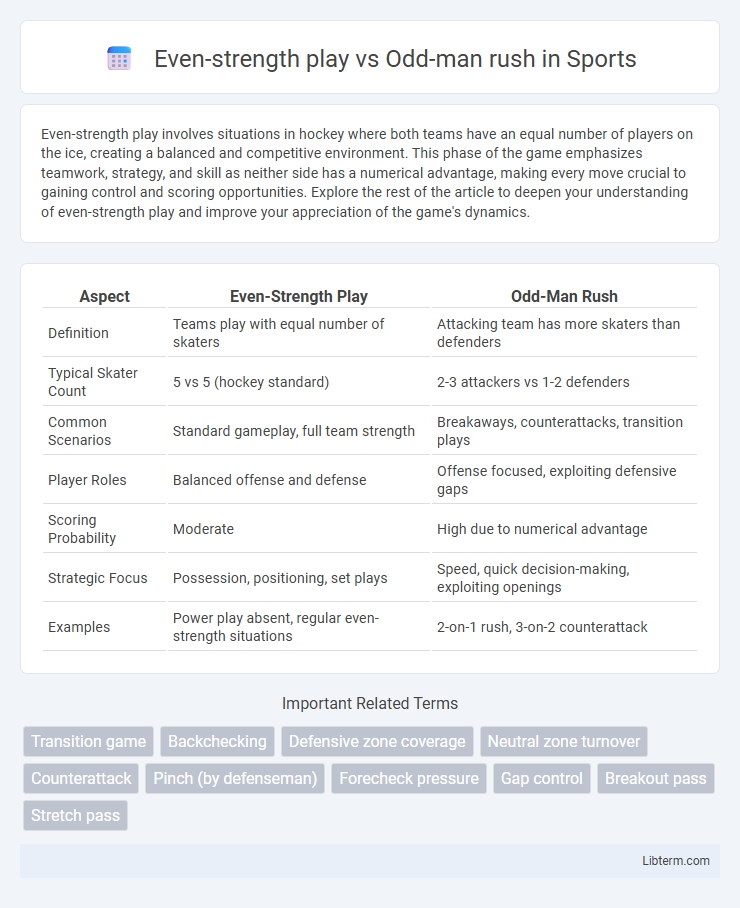Even-strength play involves situations in hockey where both teams have an equal number of players on the ice, creating a balanced and competitive environment. This phase of the game emphasizes teamwork, strategy, and skill as neither side has a numerical advantage, making every move crucial to gaining control and scoring opportunities. Explore the rest of the article to deepen your understanding of even-strength play and improve your appreciation of the game's dynamics.
Table of Comparison
| Aspect | Even-Strength Play | Odd-Man Rush |
|---|---|---|
| Definition | Teams play with equal number of skaters | Attacking team has more skaters than defenders |
| Typical Skater Count | 5 vs 5 (hockey standard) | 2-3 attackers vs 1-2 defenders |
| Common Scenarios | Standard gameplay, full team strength | Breakaways, counterattacks, transition plays |
| Player Roles | Balanced offense and defense | Offense focused, exploiting defensive gaps |
| Scoring Probability | Moderate | High due to numerical advantage |
| Strategic Focus | Possession, positioning, set plays | Speed, quick decision-making, exploiting openings |
| Examples | Power play absent, regular even-strength situations | 2-on-1 rush, 3-on-2 counterattack |
Understanding Even-Strength Play in Hockey
Even-strength play in hockey occurs when both teams have an equal number of skaters on the ice, typically five skaters plus a goalie, emphasizing balanced offensive and defensive strategies. It requires precise puck control, positional awareness, and coordinated team efforts to create scoring opportunities while minimizing turnovers. Mastering even-strength play enhances overall team performance by optimizing player deployment during the majority of game situations outside of power plays or penalty kills.
Defining Odd-Man Rush Situations
Odd-man rush situations in hockey occur when one team advances the puck with a numerical advantage over defenders, typically 2-on-1 or 3-on-2 scenarios, creating high-scoring opportunities by exploiting defensive gaps. These breakaways test defensive coordination and goalie positioning, as the attacking team can utilize speed and puck movement to outmaneuver opponents. Understanding odd-man rushes highlights the contrast with even-strength play, where equal player numbers result in more balanced defensive and offensive strategies.
Key Tactical Differences Between Even and Odd-Man Scenarios
Even-strength play involves equal numbers of skaters on both teams, emphasizing structured positioning, puck possession, and coordinated passing to create scoring opportunities while maintaining defensive integrity. Odd-man rushes occur when one team has a numerical advantage in transition, leveraging speed, spacing, and quick decision-making to outnumber defenders and generate high-percentage scoring chances. The key tactical difference lies in the balanced, methodical approach of even-strength situations versus the aggressive, fast-paced exploitation of defensive gaps during odd-man rushes.
Common Strategies for Maintaining Even-Strength Control
Maintaining even-strength control in hockey centers on effective puck possession, strong defensive positioning, and quick puck movement to disrupt opponent forechecks. Teams employ strategies such as cycling the puck along the boards, utilizing support from defensemen to create passing lanes, and maintaining gap control to prevent odd-man rushes. Emphasizing communication and anticipation allows players to intercept passes and regain possession, minimizing opposition scoring opportunities during 5-on-5 play.
Transitioning from Even-Strength to Odd-Man Rush Opportunities
Transitioning from even-strength play to odd-man rush opportunities hinges on quick puck movement and exploiting numerical advantages during turnovers. Effective breakouts and accurate passing accelerate the transition, creating open lanes for odd-man rushes that catch the opposing defense off guard. Teams that master swift puck retrieval and decision-making increase the frequency and quality of odd-man rush chances in game situations.
Defensive Challenges During Odd-Man Rushes
Odd-man rushes create acute defensive challenges by forcing fewer defenders to cover more attackers, increasing the risk of scoring chances. Defenders must quickly communicate, maintain proper gap control, and prioritize positioning to limit passing lanes and shooting opportunities. Effective anticipation and rapid transitional adjustments are critical to disrupt the offensive break and prevent high-quality scoring chances during even-strength play disruptions.
Offensive Approaches in Odd-Man Rush Situations
Odd-man rush situations provide a numerical advantage, allowing offensive players to exploit defensive gaps through quick puck movement and precise passing to create high-quality scoring chances. Speed and accurate decision-making are crucial in odd-man rushes, as attackers must coordinate to overload the defense and capitalize on open lanes or mismatches. Utilizing skilled forwards who excel in puck control and vision enhances the effectiveness of odd-man rushes by increasing shot quality and overall offensive threat.
Impact of Player Positioning on Play Outcomes
Effective player positioning during even-strength play maximizes puck control and defensive coverage, minimizing scoring chances against. In odd-man rush situations, swift transitions and strategic lane occupation by attackers exploit numerical advantages, increasing high-quality scoring opportunities. The contrast in spatial dynamics between balanced formations and breakaway attacks critically determines offensive success and defensive resilience.
Statistical Analysis: Goals from Even-Strength vs. Odd-Man Rush
Even-strength play accounts for approximately 75% of total hockey goals, highlighting its dominance in scoring opportunities, while odd-man rushes, though less frequent, boast a higher conversion rate due to numerical advantage and quick play. Analytics reveal teams score on around 15-20% of odd-man rushes compared to roughly 7-10% shooting percentage during standard even-strength situations. This statistical disparity emphasizes the critical importance of defensive positioning during odd-man rushes and the overall strategic value of capitalizing on even-strength scoring chances in game outcomes.
Coaching Tips for Managing Both Even-Strength and Odd-Man Rushes
Coaching effective even-strength play requires emphasizing positional discipline and balanced puck movement to maintain defensive integrity while generating offensive opportunities. In managing odd-man rushes, stress quick decision-making, gap control, and backchecking to disrupt opponents' numerical advantages. Drills simulating these scenarios enhance player awareness and reaction times, improving team resilience in both standard and high-pressure situations.
Even-strength play Infographic

 libterm.com
libterm.com